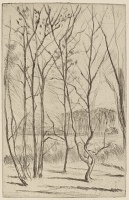Etchings Institutions search term: gutekunst
The Dam Wood | ||
| Number: | 133 | |
| Date: | 1874/1875 | |
| Medium: | drypoint | |
| Size: | 177 x 113 mm | |
| Signed: | butterfly at right (3-final) | |
| Inscribed: | no | |
| Set/Publication: | no | |
| No. of States: | 4 | |
| Known impressions: | 11 | |
| Catalogues: | K.145; M.143; W.120 | |
| Impressions taken from this plate (11) | ||
TECHNIQUE
This is entirely drypoint, although the needle has tripped at times when drawing long lines, creating a roulette-like effect.
PRINTING
One impression of the first state was printed in black ink on ivory laid paper with an Arms of Amsterdam watermark ( ), and another on cream Japan (
), and another on cream Japan ( ) paper. A second state in black ink is on an unevenly cut sheet of ivory laid paper with 'Pro Patria' watermark, possibly from a book (
) paper. A second state in black ink is on an unevenly cut sheet of ivory laid paper with 'Pro Patria' watermark, possibly from a book ( ), and others also on laid paper (
), and others also on laid paper ( ,
,  ). The third state was printed in dark brown ink on a sheet of ivory laid paper, possibly with a 'V' or 'IV' countermark, which was definitely taken from a book, with the binding holes visible along the left edge (
). The third state was printed in dark brown ink on a sheet of ivory laid paper, possibly with a 'V' or 'IV' countermark, which was definitely taken from a book, with the binding holes visible along the left edge ( ). The final state, like the first, is on Arms of Amsterdam paper (
). The final state, like the first, is on Arms of Amsterdam paper ( ). Most were printed with a broad margin but two (a second and a fourth state) were trimmed to the platemark and signed with a butterfly on the tab by Whistler years later, presumably for sale (
). Most were printed with a broad margin but two (a second and a fourth state) were trimmed to the platemark and signed with a butterfly on the tab by Whistler years later, presumably for sale ( ,
,  ).
).
 ), and another on cream Japan (
), and another on cream Japan ( ) paper. A second state in black ink is on an unevenly cut sheet of ivory laid paper with 'Pro Patria' watermark, possibly from a book (
) paper. A second state in black ink is on an unevenly cut sheet of ivory laid paper with 'Pro Patria' watermark, possibly from a book ( ), and others also on laid paper (
), and others also on laid paper ( ,
,  ). The third state was printed in dark brown ink on a sheet of ivory laid paper, possibly with a 'V' or 'IV' countermark, which was definitely taken from a book, with the binding holes visible along the left edge (
). The third state was printed in dark brown ink on a sheet of ivory laid paper, possibly with a 'V' or 'IV' countermark, which was definitely taken from a book, with the binding holes visible along the left edge ( ). The final state, like the first, is on Arms of Amsterdam paper (
). The final state, like the first, is on Arms of Amsterdam paper ( ). Most were printed with a broad margin but two (a second and a fourth state) were trimmed to the platemark and signed with a butterfly on the tab by Whistler years later, presumably for sale (
). Most were printed with a broad margin but two (a second and a fourth state) were trimmed to the platemark and signed with a butterfly on the tab by Whistler years later, presumably for sale ( ,
,  ).
).
